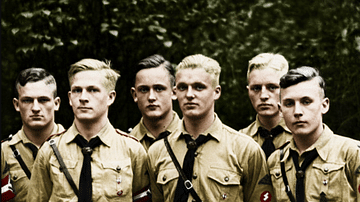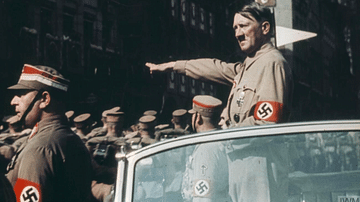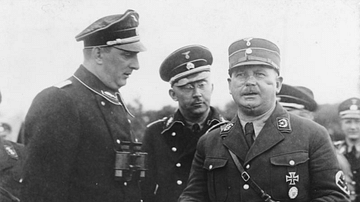
The Nazi-Soviet Pact, also called the Molotov-Ribbentrop Pact after the respective foreign ministers of the USSR and Germany, was a non-aggression agreement signed in August 1939. The pact allowed the leader of Nazi Germany Adolf Hitler (1889-1945) to attack Poland and then Western Europe without having to face at the same time a Soviet army. Meanwhile, the leader of the USSR Joseph Stalin (1878-1953) acquired freedom of action in Eastern Europe and bought valuable time to continue rearmament.
The Nazi-Soviet Pact carved up Central and Eastern Europe into two spheres of influence between the two signees, led to direct occupations of free countries, and directly influenced where much of the fighting occurred in the first two years of the Second World War (1939-45). The agreement was, though, shattered when Germany attacked the USSR in June 1941.
Hitler's Foreign Policy
In order to understand why the USSR signed a treaty with Germany and not Britain or France in 1939, it is necessary to retrace the hectic developments in European affairs through the 1930s. When Adolf Hitler took power in Germany in 1933, he set out on an aggressive foreign policy of absorbing neighbouring territories. This was something Hitler had written about in his 1925 book Mein Kampf where he described the need for Lebensraum ('living space') for the German people, that is, new lands where they could prosper. This land would be sought for in the East. In addition, Hitler had long promised the German people that he would overturn the humiliating losses and restrictions imposed by the Treaty of Versailles that formally concluded the First World War (1914-18), which Germany had lost. The Saar region was taken back (1935), the Rhineland was remilitarised and Germany began to rearm (1936), then Austria was absorbed into Hitler's Third Reich (1938). In 1938, Hitler looked to Czechoslovakia.
The League of Nations (the forerunner of today's United Nations), which had been created after WWI to promote world peace, had proved itself to be inadequate when it came to aggressor states attacking weaker states. This weakness was particularly evident when Japan invaded Chinese Manchuria in 1931 and Italy invaded Abyssinia (Ethiopia) in 1935. Hitler's aggression also failed to rouse any meaningful response from the League. The USSR's leader Joseph Stalin must have watched all of these events with dismay as Germany expanded eastwards.

The Munich Conference
Hitler's calls for the Czech Sudetenland to become part of Germany sparked what has become known as the Czech Crisis. The USSR and France had signed a treaty in 1935 promising to protect Czechoslovakia from outside aggression, but the USSR was only bound to act if France mobilised first. Hitler thought it unlikely that France would act first, certainly not without Britain, which seemed intent on avoiding war at almost any cost. France's prime minister Edouard Daladier (1884-1970) was fully aware that his country was utterly unprepared for war.
Significantly, Stalin was not invited to the Munich Conference, held on 29 and 30 September 1938. The leaders of Britain, France, Italy, and Germany met in Munich to try to avoid a war over Hitler's ambitions regarding Czechoslovakia. The prime minister of Britain Neville Chamberlain (1869-1940) did not trust Stalin. The government of Czechoslovakia was not invited to Munich either since the decision of all parties was to simply hand over the Sudetenland. With the United States pursuing a policy of isolation, Britain and France were not prepared militarily for a war with Germany, and so they pursued a policy of appeasement, that is, giving in to Hitler's demands in the hope it would be his last. With hindsight, this policy was shown to be folly since Hitler was determined to take over the whole of Europe. The Munich Agreement stipulated that Germany must promise to respect the sovereignty of the remainder of Czechoslovakia, but Hitler's occupation of the rest of Czechoslovakia in March 1939 made his intentions clear enough. Hitler began to talk next of the invasion of Poland in 1939. The hopes of Munich and appeasement were definitively shattered.
As one Soviet diplomat noted, the USSR's absence from Munich had meant not putting "our foot on a rotten plank" (Taylor, 237). It also seemed clear to Stalin in 1939 that if Germany were to attack the USSR, then neither the major powers nor the League of Nations would come to its aid. A deal of some sort with Germany now looked like the best prospect of keeping the USSR out of a war. Even if a pact with Hitler only proved to be a temporary respite, Stalin would gain valuable time for rearmament and he might negotiate some additional territory to create a buffer zone between the two states. Further, if Germany attacked Britain and France, all three armies might wear each other down to such a state of weakness that Stalin could take full advantage.

Shifting Alliances
Hitler had secured his southern flank in 1936 when he made an alliance with the fascist dictator of Italy, Benito Mussolini (1883-1945). This alliance was called the Rome-Berlin Axis. Hitler and Mussolini agreed informally at the Munich Conference that they would support each other in a coming war. On 22 May 1939, Italy and Germany signed a military alliance, the 'Pact of Steel'. Next, Hitler sought to secure his eastern flank. The 1936-7 Anti-Comintern Pact signed by Germany, Italy, and Japan, a treaty of mutual cooperation in empire-building and a united front against communism, did not deter Hitler from seeing the advantages of keeping the USSR at bay while he swept through Western Europe. Stalin had signed a non-aggression pact with Poland in 1932, but that did not deter him either from now negotiating with Hitler to see how much of that country he could grab. Both dictators were nothing if not opportunistic pragmatists.
Meanwhile, in Britain in the summer of 1939, there was a strong sentiment that the USSR could be a very useful ally against Hitler. Notable supporters of a treaty with the USSR included the opposition Labour Party and figures like Winston Churchill (1874-1965). A poll in June 1939 revealed that 84% of the British public supported an alliance with Stalin. Chamberlain, though, remained adamant regarding his anti-Stalin position, and, in any case, it was thought that since Stalin had brutally purged his armed forces, he was not much use as an ally anyway. A minor British foreign office official, William Strang, was sent to Moscow to probe the mood there, but a permanent stumbling block to progress was that the government of Poland refused to allow Soviet troops on its territory in the event that it was attacked by another country. In the end, the half-hearted British-Soviet talks fizzled out.
Molotov & Ribbentrop
Vyacheslav Molotov (1890-1986) was a veteran of the 1917 Bolshevik Revolution and gained experience in the government led by Vladimir Lenin (1870-1924). Molotov served under Stalin as the People's Commissar of Foreign Affairs, a position he took over from Max Litvinov (1876-1952) in May 1939. Litvinov, foreign minister throughout the 1930s, had ensured the USSR's entry into the League of Nations and taken a strong and definite position against Nazi Germany, preferring to pursue a collective security policy potentially involving both Britain and France. Stalin's appointment of Molotov, then, was an indicator to Hitler that there was perhaps now a chance of some sort of negotiation between Germany and the USSR. On the other hand, Molotov had a deserved reputation for being a tough-talking negotiator (his name signifies ‘hammer').
Molotov's counterpart in Germany was Joachim von Ribbentrop (1893-1946), in the role only since February 1938. Ribbentrop was a WWI veteran and he had experience living abroad, including a stint as ambassador to Britain where he managed to offend almost everyone he met, not least because he gave King George VI of Britain (r. 1936-52) a Nazi salute. It is difficult to find anything positive anyone ever said about Ribbentrop but, fiercely loyal to Hitler, he had led the negotiations for the Anglo-German Naval Agreement of 1935 and been instrumental in Japan signing the Anti-Comintern Pact.
Features of the Nazi-Soviet Pact
Germany and the USSR began diplomatic negotiations in June 1939, officially at least, these talks only concerned trade. Things began to move more quickly in August when Ribbentrop communicated to Germany's ambassador in Moscow a message to be passed on directly to Molotov:
There exist no real conflicts of interests between Germany and Russia…There is no question between the Baltic and the Black Sea which cannot be settled to the complete satisfaction of both parties.
(Taylor, 314)
Molotov received the message but indicated that negotiations between the two states would be a lengthy process and require three stages: a trade agreement, a non-aggression pact, and then an agreement on territories. Hitler, pressed for time since he fully intended to invade Poland on 1 September whatever happened (the army was already mobilising, and rains in autumn would hamper the operation), communicated directly with Stalin that he was prepared to give the USSR free rein in Eastern Europe. On 21 August, a commercial treaty between the two states was agreed. Ribbentrop was then invited to Moscow. Remarkably quickly, the two foreign ministers signed what was called the German-Soviet Treaty of Non-Aggression on 23 August 1939 in Moscow. The agreement was stripped down of all the conventional diplomatic platitudes since, as Stalin himself put it "The Soviet Government could not suddenly present to the public German-Soviet assurances of friendship after they had been covered with buckets of filth by the Nazi Government for six years" (Taylor, 318). The accord was to be a no-nonsense and ruthlessly pragmatic affair of two leaders keeping each other at arm's length and out of mutual harm. The agreement promised that neither state would attack the other, and, further, if one were attacked by a third party, the other would not aid that third party or its allies in any way.
There soon followed a wider agreement between the two states regarding Central and Eastern Europe. Then, on 28 September, the German-Soviet Treaty of Friendship, Co-operation, and Demarcation was signed. Collectively, all of these agreements are conventionally called the Molotov-Ribbentrop Pact or Nazi-Soviet Pact.
The only non-aggression part of the Nazi-Soviet Pact was the promise that the two nations would not attack each other, everyone else was fair game. Secret protocols in the agreements allowed Germany and the USSR to attack their neighbours, effectively carving up Central and Eastern Europe between them. These secret protocols were only discovered following the capture of relevant German archival documents in 1945. The Soviets denied the existence of the secret protocols until the end of the 20th century. The USSR would have freedom of action in eastern Poland, Bessarabia, Finland, Estonia, and Latvia (Lithuania was added to the list later). Germany would have its spheres of interest in western Poland and those states to the south. Finally, "Stalin promised Hitler strategic materials and foodstuffs in exchange for industrial equipment and machinery" (Boatner, 687).
Reaction to the Pact
Politicians and diplomats in Britain and France were shocked by this dangerous new development. Many communists outside the USSR distanced themselves from Stalin for negotiating with Hitler, a man who had repeatedly attacked communists in Germany. Neither Chamberlain nor Daladier could believe that Hitler had conducted an about-face on his widely-known position of being anti-communist. Stalin, they said, had written a 'blank cheque' for Hitler to attack in the West. Hitler may even have hoped the Nazi-Soviet Pact would lead both Britain and France to back away from their promise in the previous spring to protect Poland. As the Nazi leader remarked to his generals in August 1939, "The probability is still great that the West will not intervene. We must take the risk with ruthless determination...The East will supply us with grain, cattle, coal, lead and zinc" (Hite, 394-5). Hitler was wrong about Britain and France. The British government had already issued a categorical statement on 22 August that any alliance made between Germany and the USSR would not alter Britain's obligation to defend Poland. The French ambassador to Germany gave the same assurance to Hitler in a face-to-face meeting on 25 August.
War Breaks Out
Hitler invaded Poland on 1 September 1939. Britain and France, as promised, declared war on Germany on 3 September, and so the Second World War began. On 17 September, the USSR's Red Army invaded the eastern half of Poland. The implausible excuse was that they were merely entering to safeguard the future of Belorussian and Ukrainian Slavs inside Poland. The lack of modern weapons in the Polish armed forces proved telling. Most of the Polish air force was destroyed on the ground by German bombers in the first two days of the invasion. Germany's blitzkrieg tactics of combining air and mechanised land forces and attacking at high speed paid dividends. Kraków was captured on 6 September. Warsaw, the capital, surrendered on 27 September. The main fighting ended by 7 October. Poland was split down the line of the River Bug, but, as Germany's slice was slightly bigger, the USSR was permitted to do what it wanted with Lithuania. The new frontiers were recognised in the German-Soviet Treaty of Friendship, Co-operation, and Demarcation on 28 September. The USSR made client states of Estonia, Latvia, and Lithuania, although Finland stubbornly resisted the Red Army's attacks (a peace treaty was signed in March 1940).
Hitler did eventually turn to the East and attacked the USSR in Operation Barbarossa, from 22 June 1941. Once again, the Nazis dreamed up feeble excuses, complaining that the USSR had broken the spirit of the Nazi-Soviet Pact through acts of sabotage in German territory and, by massing troops in Eastern Europe, directly threatened the Third Reich. On the other side, Stalin accused Hitler of breaking the pact by mobilising German troops into Romania and Bulgaria. As the historian W. L. Shirer notes, "The thieves…had begun to quarrel over the spoils" (801).
In the event, Stalin had not used the delay in the USSR's entry into the war to increase defences in Eastern Europe and the USSR's western frontiers. Stalin's intentions are not known with any certainty, but it may be that he expected Germany's campaign in Western Europe to last several years, as it had in WWI, and he was caught off guard by the speed of Germany's occupation of the Low Countries and France, achieved by 1940. The fighting between Germany and the USSR cost millions of lives. In the end, when Germany lost WWII, Stalin proved himself the winner of his diplomatic maneuvers with Hitler, since, by 1945, the USSR had gained control not only of Eastern and Central Europe but also of the eastern half of Germany.








